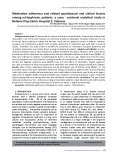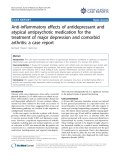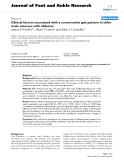
HUE JOURNAL OF MEDICINE AND PHARMACY ISSN 1859-3836 43
Hue Journal of Medicine and Pharmacy, Volume 14, No.2-2024
Medication adherence and related psychosocial and clinical factors
among schizophrenic patients: a cross - sectional analytical study in
National Psychiatric Hospital 2, Vietnam
Tran Nhu Minh Hang1*, Nguyen Van Thinh2, Nguyen Ngoc Quang Linh1
(1) Department of Psychiatry, Hue University of Medicine and Pharmacy, Hue University, Thua Thien Hue, Vietnam
(2) National Psychiatric Hospital 2, Vietnam
Abstract
Background and Aims: Schizophrenia is a chronic and severe mental disorder. Treatment by antipsychotic
medication is one of the main therapies to control the symptoms. Medication non/poor adherence is a one
of the key factors leading to relapse and declined social and occupational function in patients. However,
prevalence of schizophrenic patients with non/poor adherence to medication was quite high in previous
studies. Therefore, this study aimed to identify the prevalence of medication non/poor adherence and
its related psychosocial and clinical factors among schizophrenic patients. Subjects and Method: a cross -
sectional analytical study of 126 schizophrenic patients at National Psychiatric Hospital 2 were conducted to
evaluate the rate of medication non-adherence by Morisky Medication Adherence Scale 8 item (MMAS - 8).
Data were collected on patients’ sociodemographic factors such as sex, age, marital and economic status,
level of education and clinical factors including duration of schizophrenia, clinical symptoms evaluated by
Positive and Negative syndrome scale (PANSS), type, and side effects of medication. Logistic regression
was used to analyze the factors associated with medication non-adherence among schizophrenic patients.
Results: Rate of poor medication adherence among participants was 78.57% by using MMAS – 8. The
associated factors with poor medication adherence among schizophrenic patients were level of education
under high school; unstable job/unemployment; poor insight about schizophrenia, poor family care/support,
high scores of negative PANSS and general PANSS scale, duration of schizophrenia above 5 years, treated by
typical antipsychotics and having more than two side effects of antipsychotics. Conclusion: The rate of poor
medication adherence/ non - adherence among schizophrenic patients is high. Mental health staff should be
aware of this risk and screening individuals for relevant risk factors is highly recommended.
Keywords: medication adherence, schizophrenia, social - psycho - clinical factors.
Corresponding: Tran Nhu Minh Hang, Email: tnmhang@huemed-univ.edu.vn
Recieved: 6/2/2024; Accepted: 19/2/2024; Published: 25/2/2024
DOI: 10.34071/jmp.2024.2.6
1. INTRODUCTION
Schizophrenia is a severe and chronic mental
disorder with a lifetime prevalence estimated
at approximately 0.3% - 1% of the worldwide
population. Clinical manifestations of schizophrenia
are variable and include negative symptoms such as
poverty of speech, avolition, apathy, blunted affect,
social withdrawal, … and positive symptoms such as
delusion, hallucination, illusion, catatonic behavior,
disorganized behavior, as well as impairment of
cognition. Schizophrenic treatment is a long -term
process and incorporates variety of treatment
modalities including pharmacotherapy, social-
psychological interventions and other biological
therapies such as electroconvulsive therapy (ECT)
and Transcranial Magnetic Stimulation (TMS) [1,2].
Pharmacotherapy, especially antipsychotics, is a
mainstay treatment for schizophrenia to control the
symptoms in the acute phase and to prevent relapse
in maintenance phase [1,2]. Several previous
studies over the world showed that the rate of non
–adherence or poor adherence to medications in
schizophrenic patients was quite high [3,4]. Higashi
et al. (2013) showed that 74% of schizophrenic
patients discontinued medication after 18 months
due to side effects, poor response to medication
and other factors [3]. Kikkert M.J. and Dekker J.
(2017) found that 50% of schizophrenic patients
did not adhere to medications [4]. According to
Widschwendter CG et al. (2018), non-adherence to
medications is a major challenge in the long-term
management of schizophrenia and can be viewed
as a failure in the treatment of schizophrenia [5].
Previous studies have also indicated that poor
adherence to medication treatment could lead to
negative outcomes for schizophrenic patients such
as increased relapse rates, worsening of symptoms,
re-admissions, longer hospital stays and social


























